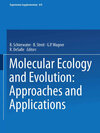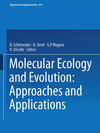
×
![Buchcover ISBN 9783764329426]()
Molecular Ecology and Evolution: Approaches and Applications
herausgegeben von B. Schierwater, B. Streit, G.P. Wagner und R. DeSalleInhaltsverzeichnis
- I: DNA fingerprinting and behavioral ecology.
- Arbitrary primer mediated fingerprinting in plants: Case studies in plant breeding, taxonomy and phylogeny.
- DNA amplification fingerprinting: A general tool with applications in breeding, identification and phylogenetic analysis of plants.
- The analysis of simple repeat loci as applied in evolutionary and behavioral sciences.
- Multilocus DNA fingerprinting and genetic relatedness in plants: A case study with banana and tomato.
- Measuring reproductive success in insects.
- Unravelling the components that underlie insect reproductive traits using a simple molecular approach.
- Molecular analysis of kinship in birds: Interesting questions and useful techniques.
- II: Population biology.
- Molecular techniques in population genetics: A brief history.
- Organization of genetic variation at the molecular level: Lessons from Drosophila.
- The use of microsatellite analysis in population biology: Background, methods and potential applications.
- The use of microsatellites for genetic analysis of natural populations.
- PCR assays of variable nucleotide sites for identification of conservation units.
- Concerted evolution and RAPping in mitochondrial VNTRs and the molecular geography of cricket populations.
- Molecular markers and evolutionary processes in hermaphrodite freshwater snails.
- Extinction and the formation of phylogenetic lineages: Diagnosing units of conservation management in the tiger beetle Cicindela dorsalis.
- Perspective on conservation genetics.
- III: Molecular systematics.
- Advances in the theory and practice of DNA-hybridization as a systematic method.
- Allozymes in mammalian population genetics and systematics: Indicative function of a marker system reconsidered.
- Analysis of DNA from natural history museum collections.
- Sources of ambiguity in nucleic acid sequence alignment.
- Computational problems in molecular systematics.
- The comparison of morphological and molecular data in phylogenetic systematics.
- Non-coding chloroplast DNA for plant molecular systematics at the infrageneric level.
- Developing model systems for molecular biogeography: Vicariance and interchange in marine invertebrates.
- Bridging phylogenetics and population genetics with gene tree models.
- IV: Speciation, development and genome organization.
- The role of molecular genetics in speciation studies.
- The origin and evolution of species differences in Escherichia coli and Salmonella typhimurium.
- The evolutionary ecology of Daphnia.
- Diversity within diversity: Molecular approaches to studying microbial interactions with insects.
- Evolutionary analysis of genes involved in early embryonic pattern formation in Drosophila.
- Developmental genes and the origin and evolution of Metazoa.
- To what extent does genetic information determine structural characteristics and document homologies?.
- Evolution and multi-functionality of the chitin system.
- Genome evolution: Between the nucleosome and the chromosome.
- Individual genes underlying quantitative traits: Molecular and analytical methods.
- Perspectives on future applications of experimental biology to evolution.




